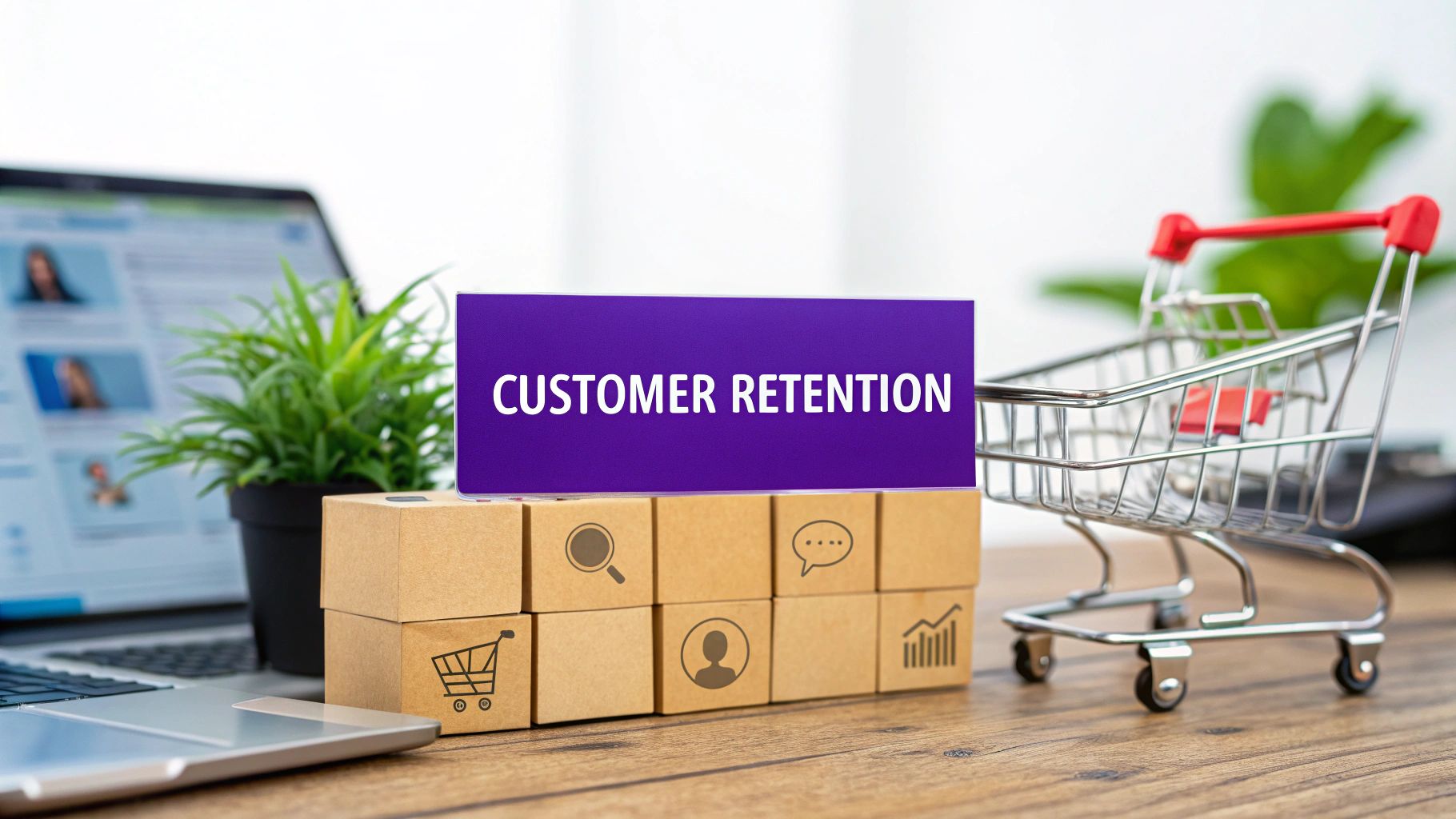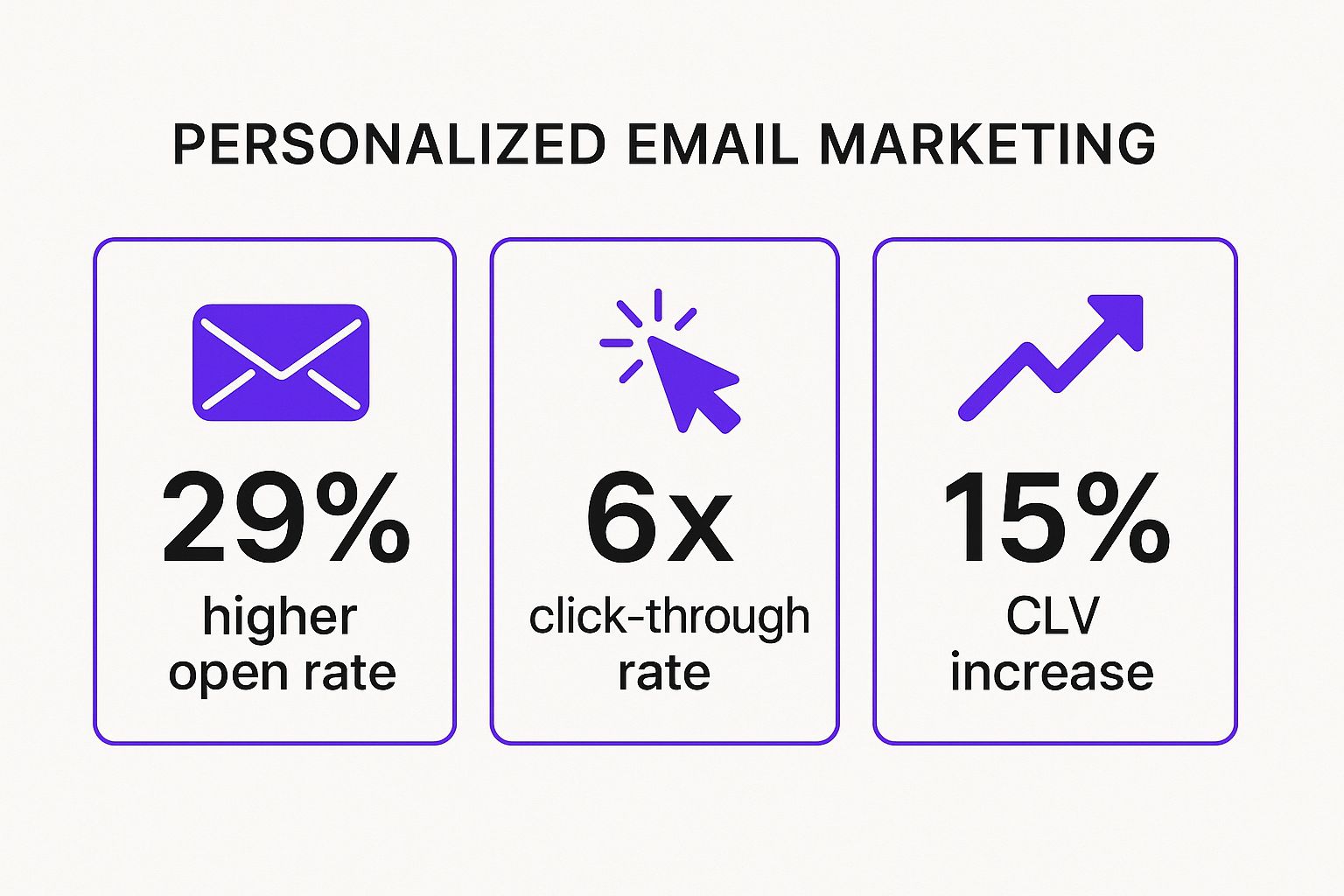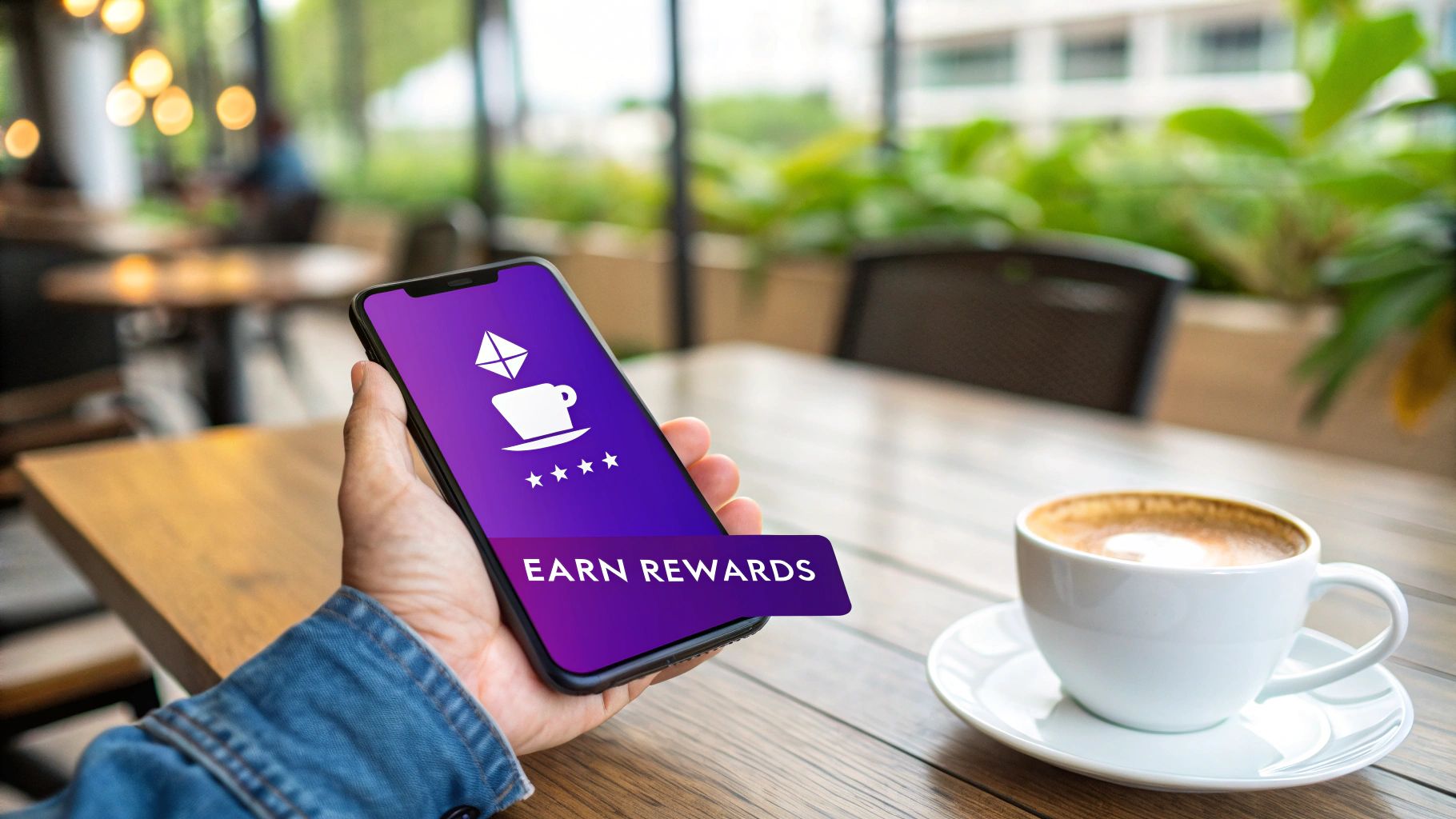9 Proven Ecommerce Customer Retention Strategies for 2025

In the fast-paced world of online retail, the chase for new customers is relentless. But what if your most valuable asset isn't a future prospect, but a past purchaser? The data is clear: acquiring a new customer can cost five times more than retaining an existing one. True, sustainable growth isn't just about attracting clicks; it's about building relationships that last. Strong ecommerce customer retention is the engine of profitability, turning one-time buyers into loyal advocates for your brand.
This shift in focus from acquisition to retention is where successful stores separate themselves from the pack. It's about creating an experience so memorable that customers choose to return again and again. Forget the generic advice. This guide provides a clear roadmap with nine proven, actionable strategies you can implement to foster that loyalty.
We’ll explore everything from hyper-personalized email campaigns and smart loyalty programs to building vibrant social communities and optimizing the critical post-purchase experience. You'll get practical steps and real-world examples needed to transform your store's approach to ecommerce customer retention and build a base of repeat buyers that fuels your growth for years to come. Let's dive in.
1. Personalized Email Marketing Campaigns
Move over, generic email blasts! The key to modern ecommerce customer retention is making your audience feel seen and valued. Personalized email marketing uses customer data, like purchase history and browsing behavior, to send hyper-relevant messages that resonate. Instead of a one-size-fits-all approach, you're crafting a unique experience for each subscriber.
This strategy goes beyond just using a customer's first name. Think of Amazon's uncanny ability to recommend products you actually want or Spotify's "Wrapped" campaign that celebrates your unique listening habits. These brands turn data into a conversation, making customers feel understood. By tailoring content, you build a stronger connection, boost engagement, and drive repeat purchases.
Why It Works for Retention
Personalization transforms your email from a simple advertisement into a valuable service. When you recommend products based on past purchases or send a reminder about an abandoned cart with the exact items they left behind, you're providing genuine utility. This thoughtful approach is a powerful tool for ecommerce customer retention because it shows you're paying attention.
The data below visualizes just how impactful this strategy can be for your key email marketing metrics.

These numbers clearly show that customers not only open personalized emails more often, but they also engage more deeply and ultimately become more valuable over time.
How to Implement It
Getting started with personalization doesn't have to be complicated. You can achieve significant results with a few focused steps:
- Start with Segmentation: Group customers by purchase history (e.g., first-time buyers, VIPs, customers who bought a specific product). Create targeted campaigns for each segment.
- Automate Abandoned Carts: Set up an automated email sequence that triggers when a customer leaves items in their cart. Feature the specific products they abandoned to entice them back.
- Use Dynamic Content: Leverage tools like Klaviyo or Mailchimp to insert personalized product recommendations directly into your emails based on a user's browsing or purchase history.
2. Loyalty Points and Rewards Programs
Rewarding repeat business is a classic, yet incredibly effective, strategy for keeping customers coming back. A loyalty program formalizes this appreciation by offering tangible benefits like points, credits, or exclusive perks every time a customer makes a purchase. This approach gamifies the shopping experience and creates a powerful psychological incentive to choose your brand over a competitor.
Think about the giants who have mastered this: Sephora's Beauty Insider program makes customers feel like VIPs with birthday gifts and exclusive access, while the Starbucks Rewards app has become an integral part of the daily coffee run for millions. These programs succeed by making customers feel invested in the brand, transforming transactional relationships into long-term loyalty. This is a cornerstone of effective ecommerce customer retention.

Why It Works for Retention
A well-designed loyalty program gives customers a compelling reason to stick with you beyond just your products. It directly answers the question, "What's in it for me?" By offering clear, achievable rewards, you increase the perceived value of every purchase. This creates a positive feedback loop: customers shop, earn points, and return to redeem those points, often making another purchase in the process.
This system builds a barrier against competitors. Even if another store offers a similar product, a customer is more likely to stay with you to continue earning points toward their next reward. It’s a powerful tool for ecommerce customer retention because it shifts the focus from a single transaction to the long-term relationship.
How to Implement It
Launching a successful loyalty program is more accessible than ever with modern ecommerce platforms and apps. Focus on simplicity and value to get started:
- Keep It Simple and Transparent: Ensure customers can easily understand how to earn and redeem points. A confusing system will deter participation. Clearly display a customer's point balance on their account page.
- Offer Tiered Rewards: Create tiers (e.g., Bronze, Silver, Gold) that unlock better benefits as customers spend more. This encourages higher average order values and makes your most loyal customers feel especially valued.
- Use Bonus Point Events: Create urgency and drive sales during slower periods by offering double or triple points on specific products or for a limited time. This gives customers an extra nudge to make a purchase now.
3. Subscription and Membership Models
Why chase one-off sales when you can build a reliable, recurring revenue stream? Subscription and membership models transform transactional customers into loyal community members by offering products, services, or perks on a regular basis. This approach locks in future sales, creating a predictable foundation for growth while delivering unmatched convenience and value to your customer base.

This strategy was pioneered by disruptors like Dollar Shave Club, which turned a simple razor into a monthly convenience, and Amazon Prime, which made a membership feel indispensable. By offering exclusive benefits, from cost savings to special access, you give customers a compelling reason to stick around for the long haul.
Why It Works for Retention
Subscriptions fundamentally change the customer relationship from a series of individual purchases to an ongoing partnership. This built-in loyalty loop is a goldmine for ecommerce customer retention because it automates repeat business. Instead of constantly reminding customers to come back, you become an integrated part of their routine.
The model’s success lies in the value exchange. Customers get convenience, curation, or cost savings, while you get predictable revenue and a direct line to your most engaged audience. This steady relationship allows you to gather richer data, further personalizing the experience and strengthening the bond over time.
How to Implement It
Launching a subscription service is more accessible than ever. Focus on creating an offer that feels like a genuine upgrade, not just a payment plan.
- Offer Flexibility: Allow customers to easily pause, skip a delivery, or swap products. This sense of control reduces churn and shows you respect their needs.
- Create Exclusive Perks: Go beyond the product itself. Offer members-only content, early access to new launches, or exclusive discounts on other items in your store.
- Focus on the Value Proposition: Clearly communicate the benefits. Is it convenience (replenishment), curation (discovery boxes), or cost savings (subscribe and save)? Make the "why" impossible to ignore.
4. Exceptional Customer Service and Support
In an age of endless choice, exceptional customer service is no longer a "nice-to-have"; it's a powerful differentiator. This strategy moves beyond just answering questions and involves creating memorable, positive interactions at every touchpoint. It's about turning a routine support ticket or a simple return into an experience that makes a customer feel genuinely cared for and valued.
Think of Zappos, which built its empire not just on selling shoes but on its legendary customer service culture. Similarly, Chewy delights pet owners with handwritten notes and even pet portraits. These brands understand that outstanding support transforms satisfied shoppers into loyal brand advocates, making this approach a cornerstone of ecommerce customer retention. A cornerstone of lasting customer relationships is providing exceptional customer service and support, which is often rooted in comprehensive customer experience strategies.

Why It Works for Retention
Excellent service builds trust and emotional connection. When a customer knows they can count on you to resolve issues quickly and painlessly, they have every reason to shop with you again. A single positive service experience can erase a negative product issue and secure future loyalty. It’s a direct investment in the customer relationship that pays dividends through repeat business and powerful word-of-mouth marketing. By solving problems proactively and with empathy, you show customers they are more than just a transaction.
How to Implement It
You don't need a massive call center to deliver stellar service. Focus on creating a supportive and empowered culture with these steps:
- Empower Your Frontline: Give your support staff the autonomy to make decisions and solve problems without needing multiple approvals. This speeds up resolutions and makes customers feel heard.
- Implement Feedback Loops: Actively solicit feedback after service interactions using simple surveys. Use this data to identify pain points and continuously refine your processes and training.
- Focus on Holistic Training: Don't just train staff on your products. Invest heavily in soft skills like active listening, empathy, and conflict resolution to handle every interaction with grace.
- Provide Contextual Support: Use a CRM or helpdesk software that gives your team a full view of the customer's history, including past orders and previous support tickets, for more personalized and efficient help.
5. Retargeting and Behavioral Tracking
Ever feel like a product you looked at once is following you around the internet? That’s retargeting, and it’s a powerhouse strategy for ecommerce customer retention. This approach uses behavioral tracking to show targeted ads only to people who have already visited your site, viewed a product, or even added an item to their cart. It’s the digital equivalent of a friendly nudge, reminding customers about what they loved.
This isn't about aimlessly showing ads to everyone. It's about precision. Think of how Facebook's dynamic product ads show you the exact pair of shoes you left in your cart, or how Amazon's ads seem to know what you were just browsing. By using data on past interactions, you can bring shoppers back to complete a purchase, keeping your brand top of mind long after they’ve left your website.
Why It Works for Retention
Retargeting is effective because it focuses your ad spend on a warm audience, people already familiar with and interested in your brand. Instead of starting from scratch, you’re reigniting existing interest. This repeated, relevant exposure builds brand recognition and trust, encouraging customers to return not just once, but again and again. It’s a crucial tool for transforming one-time visitors into loyal, repeat buyers.
By reminding them of specific items they considered, you’re not just advertising; you're continuing a conversation they already started. This personalized follow-up makes customers feel seen and significantly increases the likelihood of them returning to finalize their purchase, strengthening the customer lifecycle.
How to Implement It
You can launch a powerful retargeting campaign by leveraging platforms designed for this exact purpose. Here’s how to get started:
- Segment Your Audiences: Don't treat all visitors the same. Create separate retargeting lists for different behaviors, such as "viewed product but didn't add to cart," "abandoned cart," and "past purchasers." Tailor your ad creative to each group.
- Set Frequency Caps: To avoid annoying potential customers, limit how many times a single person sees your ad within a specific period. This prevents ad fatigue and keeps the experience positive.
- Use Exclusion Lists: Be smart with your targeting. Exclude recent purchasers from campaigns promoting items they just bought. Instead, you can add them to a separate list for cross-selling complementary products after a set time.
6. Social Media Community Building
Your social media pages shouldn't just be digital billboards for your products. The real power for ecommerce customer retention lies in transforming your followers from passive observers into an active, engaged community. This involves creating a space where customers can connect with your brand and, more importantly, with each other.
Think about how brands like Lululemon have built a movement around fitness or how Sephora’s Beauty Insider community empowers customers to share reviews and tutorials. They aren’t just selling products; they are facilitating shared experiences and conversations. This approach turns one-time buyers into loyal brand advocates who feel a genuine sense of belonging.
Why It Works for Retention
A strong community gives customers a reason to stick around long after their initial purchase. It transforms the transactional relationship into an emotional one. When customers feel like they are part of an exclusive group, they are more likely to participate, share user-generated content, and defend your brand, creating a powerful moat against competitors.
One of the most effective ways to foster these long-term customer relationships and boost retention is by applying effective social media community building tips. This strategy provides ongoing value beyond your products, making your brand an integral part of your customers' lifestyle or hobby. This sense of belonging is a key driver for repeat business and lifelong loyalty.
How to Implement It
Building a thriving community requires a focus on value and genuine interaction, not just sales pitches. Here’s how to get started:
- Encourage User-Generated Content (UGC): Create a branded hashtag and run contests or feature customer photos on your feed. This makes your audience feel seen and provides you with authentic social proof.
- Provide Exclusive Value: Offer community-only perks like early access to sales, exclusive content, or live Q&A sessions with your team. This rewards members for their loyalty.
- Engage Authentically: Respond to comments and messages quickly and with personality. Use social listening tools to find and join conversations about your brand, showing you're actively present and listening.
7. Post-Purchase Experience Optimization
The sale is just the beginning, not the end, of the customer journey. Optimizing the post-purchase experience means focusing on everything that happens after a customer clicks "buy." This includes order confirmation, shipping updates, the unboxing experience, and follow-up communications. It's about transforming a simple transaction into a memorable, delightful event that builds lasting loyalty.
Think about the premium feel of unboxing an Apple product or the joy of finding unexpected stickers in a package from Glossier. These brands understand that the moments after purchase are critical for shaping customer perception. By exceeding expectations during this phase, you reinforce the customer's decision to buy from you and lay the groundwork for their next purchase, turning a one-time buyer into a lifelong fan.
Why It Works for Retention
A superior post-purchase experience is a powerful engine for ecommerce customer retention because it directly addresses the period of highest anticipation and potential anxiety for a customer. Timely shipping updates reduce worry, while a beautiful unboxing experience creates a positive emotional connection to your brand. This attention to detail shows customers you care about their entire experience, not just their money.
When you nail this phase, customers feel valued and are more likely to share their positive experience online, generating word-of-mouth marketing. It confirms their purchase was a smart choice, making them significantly more likely to return.
How to Implement It
You can start creating a standout post-purchase experience by focusing on a few key areas that deliver immediate impact:
- Invest in Branded Packaging: Go beyond a plain brown box. Use custom tape, branded tissue paper, or unique mailers that create a memorable unboxing moment.
- Send Proactive Shipping Updates: Don't wait for customers to ask "Where's my order?" Use an app like AfterShip to send branded, proactive email or SMS updates for every step of the delivery process.
- Include Surprise and Delight Elements: Add a small, unexpected gift like a free sample, a handwritten thank you note, or a discount code for a future purchase.
- Simplify Returns and Exchanges: Make your return policy easy to find and understand. A hassle-free return process builds trust and encourages customers to buy again with confidence.
8. Data-Driven Customer Segmentation
Going beyond basic groups like "new customers" is where the real magic of ecommerce customer retention happens. Data-driven customer segmentation uses advanced analytics to divide your audience into distinct groups based on their behaviors, preferences, and potential lifetime value. This allows you to stop shouting the same message at everyone and start whispering the right message to the right person.
This is a more sophisticated approach, moving from broad categories to nuanced micro-segments. Think of how Netflix analyzes your viewing habits not just to recommend movies but to create entirely new shows it predicts you'll love. Or how Uber segments riders by their travel patterns to offer targeted promotions for airport trips or daily commutes. They use data to understand motivations and meet customers where they are.
Why It Works for Retention
Segmentation creates relevance at scale, which is a cornerstone of modern ecommerce customer retention. When you understand a specific group's needs, you can tailor your marketing, product recommendations, and even customer service to resonate deeply. A high-value VIP customer should receive a different offer than a price-sensitive, one-time buyer who only shops during sales.
This targeted communication makes customers feel understood and valued, fostering a sense of loyalty that a generic approach can't match. It prevents churn by proactively addressing the specific needs and desires of different customer cohorts, ensuring your efforts are both efficient and effective.
How to Implement It
You don't need a team of data scientists to get started. Begin with accessible data and build from there.
- Start with Simple Models: Begin by segmenting based on Recency, Frequency, and Monetary (RFM) analysis. Identify your champions (high RFM), at-risk customers (low Recency), and new customers.
- Focus on Actionable Segments: Create segments that you can actually market to differently. For example, create a "Weekend Shoppers" segment and send them special offers on Friday afternoons.
- Leverage Your Platform's Tools: Most ecommerce platforms and email marketing tools (like Shopify, Klaviyo, or Hubspot) have built-in segmentation capabilities. Use them to create groups based on purchase history, product categories viewed, or average order value.
- Test and Refine: Don't set your segments and forget them. Regularly test different messages and offers for each group to see what works, and update your segments as new customer data comes in.
9. Omnichannel Experience Integration
Today's customers don't see channels; they just see your brand. An omnichannel experience ensures that every interaction, whether on your website, mobile app, social media, or in a physical store, is seamless and connected. It’s about creating a single, unified customer journey that lets shoppers move between touchpoints without losing context or convenience.
This approach treats all platforms as part of one holistic ecosystem. Think of how Target lets you browse online, add an item to your cart on their app, and then complete the purchase for in-store pickup, all without a single hiccup. This continuity makes shopping effortless and is a cornerstone of modern ecommerce customer retention, building loyalty through superior convenience.
Why It Works for Retention
An omnichannel strategy is a powerful tool for ecommerce customer retention because it puts the customer firmly in control of their shopping experience. It removes friction by meeting them on their preferred channel at any given moment. When a customer's profile, cart, and history are synced everywhere, it shows you recognize and value their entire relationship with your brand, not just a single transaction.
This unified view builds deep-seated loyalty. Customers who engage with a brand across multiple channels have a significantly higher lifetime value. They return more often because the experience is consistent, reliable, and tailored to their lifestyle, making your brand the path of least resistance.
How to Implement It
Creating a true omnichannel experience requires synchronizing your technology and operations. Here’s how to get started:
- Unify Customer Data: Use a Customer Data Platform (CDP) or a robust CRM to create a single view of each customer, combining their online browsing, purchase history, and in-store interactions.
- Bridge Online and Offline: Implement services like "buy online, pick up in-store" (BOPIS) or "ship from store." Use technology like QR codes in-store to link physical products to online reviews and information.
- Maintain Consistent Branding: Ensure your brand's voice, messaging, and visual identity are identical across all channels, from your email newsletters to your in-store signage.
- Train Your Team: Equip your customer service and in-store staff with the tools and training to see a customer's full history, enabling them to provide seamless support regardless of where the initial interaction occurred.
Customer Retention Strategies Comparison
From Strategy to Success: Your Next Steps in Retention
We've explored a powerful arsenal of ecommerce customer retention strategies, from the deep personalization of email marketing to the seamless integration of an omnichannel experience. The journey from a one-time buyer to a lifelong brand advocate is paved with intentional, value-driven interactions. The key takeaway isn't to frantically implement all nine strategies at once. Instead, view them as a menu of opportunities to strengthen your customer relationships. For many brands, especially those growing beyond marketplaces like Etsy, mastering these direct-to-consumer tactics is the most critical step toward sustainable, independent growth.
The true magic of effective ecommerce customer retention lies in its compounding effect. A well-executed loyalty program doesn't just encourage another purchase; it creates a feeling of belonging. Exceptional customer service doesn't just solve a problem; it builds trust and transforms a potentially negative experience into a positive one. Optimizing your post-purchase journey doesn't just deliver a package; it extends the excitement of the purchase and sets the stage for the next one. Each strategy reinforces the others, creating a cohesive ecosystem that makes customers feel seen, valued, and understood.
Your Actionable Path Forward
To avoid feeling overwhelmed, choose one or two strategies that align most closely with your current business goals and customer feedback. Here’s a simple way to start:
- If you want quick wins: Begin with post-purchase experience optimization. A simple, personalized thank you email or a branded tracking page can make an immediate impact.
- If you have rich data: Dive into data-driven customer segmentation. Use your existing sales history to create targeted campaigns for your highest-value customers or those at risk of churning.
- If you want to build a community: Focus on social media engagement and community building. Create exclusive groups or use interactive content to foster a sense of connection around your brand.
Think of retention as an ongoing conversation, not a one-time announcement. It requires listening, adapting, and consistently showing up for your audience. To solidify your retention efforts and ensure long-term success, understanding how to actively reduce customer churn is paramount. Explore more on proven SMS marketing strategies to reduce churn rate to add another powerful tool to your retention toolkit. By focusing on keeping the customers you’ve already earned, you’re not just saving on acquisition costs; you’re building a stable, predictable revenue stream and a resilient business that can thrive in any market.
Ready to build a high-performing site that turns these retention strategies into reality? Wand Websites specializes in creating conversion-focused stores that empower brands to grow, scale, and thrive independently. You bring the magic; we'll build the platform that lets it shine.


